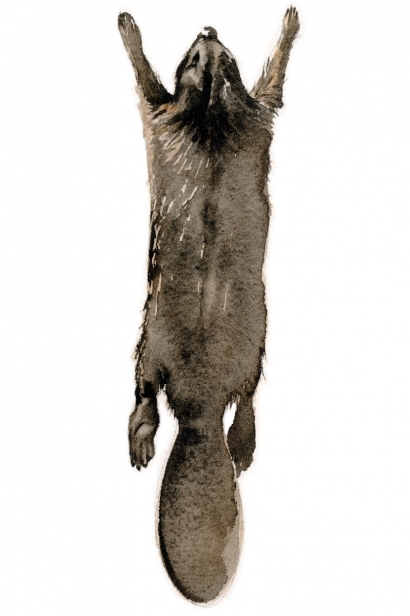If you are like me you can vividly remember this powerful scene from the long-lost program “Northern Exposure” where Marilyn explains to Ed that the wisest amoung us can’t always tell if something is good or bad news. I know the clip isn’t great quality, but be patient and think of it like delicate pot shards recovered at that most sacred archeological site in Turkey, Göbekli Tepe. Not pretty, but profoundly worth your time and careful consideration. Today especially because we are going to talk about a beaver news story that leaves me exactly as to undecided whether it’s horrific or enlightened.
Merry Lea Students Forage on Canoe Trip Along Elkhart River

Every year in September, I lead students from Goshen College’s Sustainability Leadership Semester on an eight-day canoe trip from the headwaters of the Elkhart River at Merry Lea Environmental Learning Center to Lake Michigan. Along the river we forage wild food and meet with local entrepreneurs, pastors, artists, community developers, restaurateurs, professors, NGO professionals, residents,  farmers and political leaders. In these interactions we explore many ways to contribute to resilience in our places and sustainable futures for our communities. Michiana’s local foods community is a main thread in our conversations.
farmers and political leaders. In these interactions we explore many ways to contribute to resilience in our places and sustainable futures for our communities. Michiana’s local foods community is a main thread in our conversations.
Our paddles churn the surface of the Elkhart River as our canoes glide around a sweeping bend. The world is glowing green beneath the  shade of the broad-leafed sycamore canopy on this crisp afternoon. Cardinal flowers bow to the river, red from the dark, exposed soil. A great blue heron spooks downstream as a train rumbles by on the riverside rail. Soon we see fluorescent orange and yellow in the crook of a two-trunked wild cherry tree. As we float closer, we confirm that what we’re seeing is an edible mushroom called chicken of the woods.
shade of the broad-leafed sycamore canopy on this crisp afternoon. Cardinal flowers bow to the river, red from the dark, exposed soil. A great blue heron spooks downstream as a train rumbles by on the riverside rail. Soon we see fluorescent orange and yellow in the crook of a two-trunked wild cherry tree. As we float closer, we confirm that what we’re seeing is an edible mushroom called chicken of the woods.
So far so good, right? A nature-focused outdoorsy college leads a group of students on a canoe journey down a river in Indiana hoping to teach them what they will need about sustainability to be tomorrows leaders.
But like everything in life, the story gets more complicated.
I receive a call from a friend who works for the county ditch and drain commission removing beavers from agricultural ditches to keep water levels down for row crop farmers.
“Hey, I have a beaver if you still want him.”
“Yes! Can you make it to the feast?”
“I’ve been trapping for 30 years and I’ve always wanted to try the tail. Read about it in Lewis and Clark’s journals. I’ll be there.”
Oh. So we’re going to celebrate this lovely and sustainable journey by eating an ecosystem engineer? I’m thinking this is suddenly less idyllic.
If it were up to me, the beavers would stay alive and well, creating rich wetlands as they do. However, since the trapped animals are usually left for coyotes, I feel OK about gleaning this food as a learning experience.
Now I’m just confused. Obviously you know why beavers matter, and that’s good. I assume you’ll talk with your students about that. And I kind of agree with you that its better not to waste what was killed. But I’m still saying EW.
We return to Merry Lea Environmental Learning Center, where the students live in community for the rest of the semester at Rieth Village, residential cottages that model environmentally conscious design.
 We process the beaver together, first removing his beautiful skin. For some of the students, it is the first time they have processed an animal they would later eat. Beneath the skin is scarlet muscle. We remove the tenderloins along the inside and outside of the spine, the front and back legs and the tail.
We process the beaver together, first removing his beautiful skin. For some of the students, it is the first time they have processed an animal they would later eat. Beneath the skin is scarlet muscle. We remove the tenderloins along the inside and outside of the spine, the front and back legs and the tail.
The next evening, the group transforms the meat into tikka masala; salsa verde saute; traditional roast with carrots, onions and potatoes; charcoal-grilled tail; and teriyaki tenderloin.
This meaningful, delicious meal inspires lively conversation around the table. We wonder what other sources of sustenance and significance might surround us in everyday places we have yet to discover. As we eat, we recount the gifts that this journey has given and savor Michiana’s original flavors.
Sigh.
You can understand now I bet why I chose Marilyn’s wise tale to accompany this post. There is no way to decide whether this academic exercise is wise or barbaric. If the author knows how valuable beavers are to wetlands then why is he friends with a trapper anyway? And what would happen if they used all that student energy to install a flow device instead so that the beaver could stick around and create better conditions and biodiversity instead of being dinner?
This is a sustainability course right? You know beavers can help with that don’t you?
I remain torn about this story. Joel Pontius clearly believes in working with nature in a sustainable way when it’s at all possible. He wants his students to learn about nature, not just use it and remove it. He’s not happy the beaver was trapped. but he is happy his students can learn from the experience. And to be honest, we’re talking Indiana, for goodness sake, so we’re grading on a curve.
Usually by the end of an article I know how I feel about the subject, and certainly how I want my readers to feel. Not this time. There is only one reasonable answer I can think of.

Joel needs a copy of Eager.



 YELLOWSTONE NATIONAL PARK, Wyoming – Yellowstone’s wolves are back, helping revive parts of the ecosystem that changed drastically when this top-of-the-food-chain predator was killed off nearly a century ago. But Yellowstone is still not 100% back to normal – and it may never be.
YELLOWSTONE NATIONAL PARK, Wyoming – Yellowstone’s wolves are back, helping revive parts of the ecosystem that changed drastically when this top-of-the-food-chain predator was killed off nearly a century ago. But Yellowstone is still not 100% back to normal – and it may never be. It’s a sign of both the promise – and the limitations – of a multi-decade wildlife recovery effort. The reintroduction of the wolf nearly 25 years ago to the country’s first national park has brought change: Overpopulated elk herds have thinned, allowing some willow and aspen groves to return and thereby creating better habitat for songbirds and beavers.
It’s a sign of both the promise – and the limitations – of a multi-decade wildlife recovery effort. The reintroduction of the wolf nearly 25 years ago to the country’s first national park has brought change: Overpopulated elk herds have thinned, allowing some willow and aspen groves to return and thereby creating better habitat for songbirds and beavers. 
 Okay, I’ve checked all the website places I can think of to see if they’re fixed.
Okay, I’ve checked all the website places I can think of to see if they’re fixed.
 Nice to think of the big beaver mobile they want to put together. Traveling around the state picking up unwanted beavers and putting them in just the right home.
Nice to think of the big beaver mobile they want to put together. Traveling around the state picking up unwanted beavers and putting them in just the right home.
 If this is a gift from the gods I’m just going to take it. Let’s all pretend that the last five days never happened. I spent yesterday trying to restore to a good place and things got steadily worse from there. Maybe this is the eye of the storm. Whatever it is I’m talking it.
If this is a gift from the gods I’m just going to take it. Let’s all pretend that the last five days never happened. I spent yesterday trying to restore to a good place and things got steadily worse from there. Maybe this is the eye of the storm. Whatever it is I’m talking it.
 Beavers and their dams altered not just our continent, but the lives and the evolutionary paths of a veritable Noah’s Ark of North America’s creatures. Indeed, the beaver is perhaps the best example of a keystone species—that is, one on which so many others depend. Songbirds, snow geese, otters, herons, pelicans, snakes, mink, raccoon, northern leopard frogs, sawflies, and trumpeter swans, to start. Even salmon, perhaps the last species you’d expect to benefit from nature’s most famous dam builders, owe a debt to beavers (Goldfarb quoted a bumper sticker: “Beavers taught salmon to jump”). Long before Goldfarb describes the beaver’s teeth as “evolution’s most consequential dental sculptors,” he should have you convinced.
Beavers and their dams altered not just our continent, but the lives and the evolutionary paths of a veritable Noah’s Ark of North America’s creatures. Indeed, the beaver is perhaps the best example of a keystone species—that is, one on which so many others depend. Songbirds, snow geese, otters, herons, pelicans, snakes, mink, raccoon, northern leopard frogs, sawflies, and trumpeter swans, to start. Even salmon, perhaps the last species you’d expect to benefit from nature’s most famous dam builders, owe a debt to beavers (Goldfarb quoted a bumper sticker: “Beavers taught salmon to jump”). Long before Goldfarb describes the beaver’s teeth as “evolution’s most consequential dental sculptors,” he should have you convinced. 



































